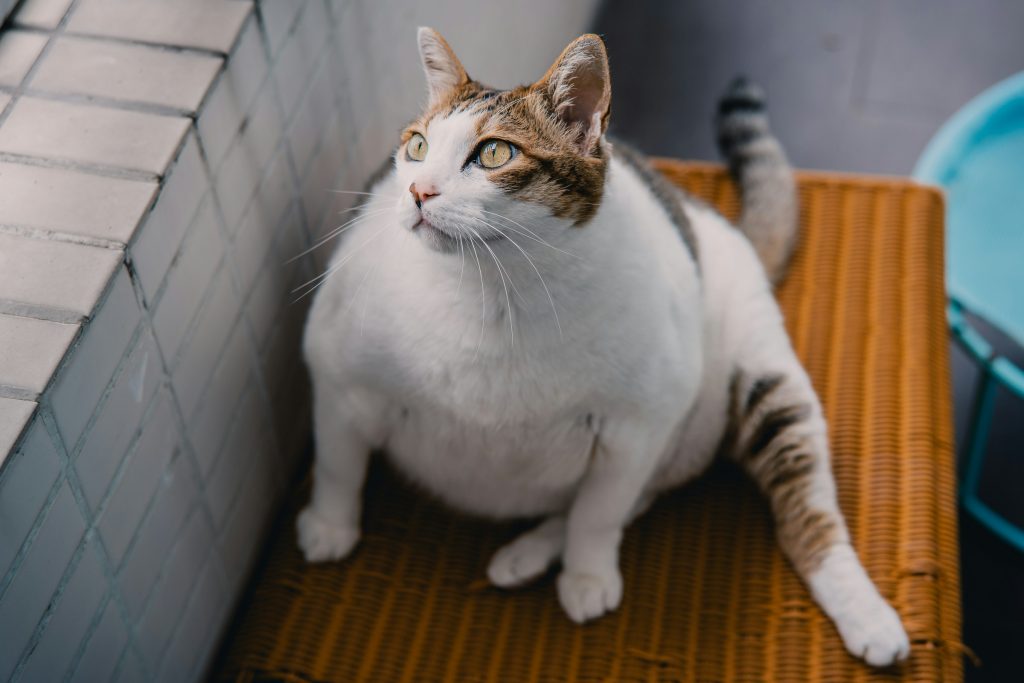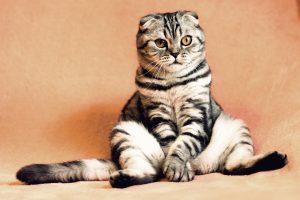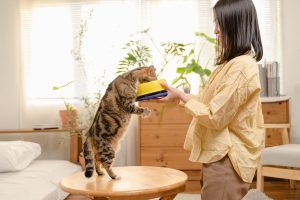
15 Smart Ways to Help Overweight Cats Slim Down in Small Apartments
If your cat’s starting to resemble a loaf more than a lean predator, you’re not alone. Obesity in cats is shockingly common—and in small apartments where vertical space is limited and outdoor access is rare, it’s easy for the pounds to creep on. But helping overweight cats lose weight doesn’t require a backyard or a home gym. With a few smart strategies and consistency, even apartment dwellers can help their cats trim down safely.
According to VCA Hospitals, overweight cats are more likely to suffer from diabetes, arthritis, liver disease, and shortened lifespans. The good news? Most cases are preventable—or reversible. And with a few changes to how you feed, play with, and structure your cat’s day, you can start seeing progress in just a few weeks.
This post walks you through 15 apartment-friendly ways to help your cat slim down gently and sustainably. From meal strategies to enrichment setups to clever movement hacks, every tip is practical for even the tiniest living spaces. Let’s help your feline feel better, move easier, and live longer—without ever stepping outside.
1. Measure Every Meal (No More Free Feeding)
One of the most common causes of overweight cats is free feeding—leaving dry food out all day for grazing. While it seems convenient, this leads to constant snacking and calorie overload. Instead, switch to scheduled meals and use a measuring cup to portion the exact amount based on your cat’s weight goal.
According to PetMD’s feeding guide, dividing daily food into 2–3 smaller meals improves digestion and curbs overeating. This is especially helpful in small apartments where boredom can lead to food-seeking behavior.
2. Use Puzzle Feeders or Treat Balls
Turn mealtime into playtime by using puzzle feeders or rolling treat balls. These tools force your cat to work for their food, slowing down eating while encouraging movement and mental engagement. It’s one of the easiest ways to add calorie-burning activity into your cat’s day—even in tight spaces.
Start with something simple and gradually increase the challenge. You can also DIY puzzles with cardboard boxes or muffin tins and paper balls. For storage-friendly ideas, check out our pet organization hacks for keeping feeding tools tidy in small apartments.
3. Switch to Low-Calorie or Weight-Management Food
Not all cat foods are equal when it comes to weight loss. Even if you’re measuring portions, high-calorie or carb-heavy formulas can keep your cat’s weight stagnant. Look for a veterinary-approved weight management blend—often labeled as “light,” “indoor,” or “weight control.”
Gradually transition over 7–10 days to avoid digestive upset. Wet food is often more filling and lower in calories per gram, which may help your cat feel full with less. Ask your vet for guidance on selecting a formula that supports fat loss while maintaining muscle mass.
4. Eliminate Table Scraps and High-Calorie Treats
Many well-meaning pet parents sabotage progress by offering bits of cheese, meat, or commercial treats that are calorie-dense and nutritionally unnecessary. For overweight cats, these extras quickly add up and stall weight loss—even if meals are well-controlled.
Stick to healthy alternatives like freeze-dried chicken or small portions of your cat’s regular kibble. Better yet, reserve all treats for training, play, or puzzle time so they serve a purpose. Cutting just 10–15 calories a day can make a major difference over time.
5. Schedule Short Play Sessions Multiple Times a Day
Overweight cats often have low energy—not because they’re lazy, but because they’ve been conditioned to be sedentary. The solution isn’t one long workout, but several short bursts of fun throughout the day. Five minutes here and there adds up fast.
Use feather wands, laser pointers, or crinkle tunnels to get your cat moving. Rotate toys often to keep things interesting. A short pre-meal play session can also help activate their metabolism. For more creative ideas, visit our indoor pet games guide—many work great for cats too.
6. Make Vertical Climbing a Daily Habit
Climbing is natural for cats—and a surprisingly effective way to burn calories. Even in small apartments, you can encourage movement by placing a cat tree, staggered shelves, or a window hammock at varying heights.
Overweight cats may resist climbing at first, so make it rewarding. Use treats or toys to lure them up, and praise them at the top. Choose stable, low-entry structures until they build confidence. The more they stretch and jump, the more muscle they’ll rebuild.
7. Stick to a Routine Feeding Schedule
Cats thrive on routine—and so does weight loss. Feeding overweight cats at consistent times each day supports better metabolism, limits begging behavior, and helps you track intake. It also mimics the rhythm of hunting and resting, which is how cats are wired.
Try feeding in the morning and evening at roughly the same times, with a third meal optional if you're dividing portions. Post-meal play sessions can help reinforce the pattern. If your schedule varies, an automatic feeder can help maintain consistency.
8. Keep Food and Water Bowls Separate
It may sound minor, but separating your cat’s food and water can encourage natural movement throughout the day. Instead of clustering everything in one corner, place their water bowl in a different room to prompt extra walking.
Bonus: many cats prefer not to eat and drink in the same spot. By spreading out essentials, you’re subtly encouraging more movement, which adds up over time—especially for indoor, overweight cats with limited space.
9. Rule Out Underlying Medical Conditions
If your cat is gaining weight despite a healthy diet and regular play, it's time to consult your vet. Conditions like hypothyroidism, joint pain, or even early diabetes can contribute to weight gain or lethargy—especially in older cats.
A full check-up can rule out hidden causes and provide a tailored plan. Your vet might suggest bloodwork, a body condition scoring chart, or a prescription weight-loss diet designed specifically for overweight cats.
10. Avoid Feeding Out of Boredom
When your cat meows or stares at you intently, it’s tempting to assume they’re hungry. But many cats, especially indoor ones, signal boredom—not hunger. Over time, this reinforces a cycle of emotional eating that leads to weight gain.
Next time your overweight cat “asks” for food outside of meal time, try initiating a short play session, brushing, or window time instead. You might find they quickly forget the food and settle happily once their attention is redirected.
11. Track Progress with Monthly Weigh-Ins
Without data, it’s hard to know what’s working. Weigh your cat monthly and keep a written log to track progress. Many pet parents don’t realize their overweight cat is losing weight gradually—until they see it on paper.
Use a pet scale or weigh yourself holding your cat, then subtract your own weight. Aim for slow, steady weight loss—about 0.5–1% of body weight per week. Sudden drops can be dangerous and should be reviewed by a vet immediately.
12. Be Patient—And Celebrate Small Wins
Helping overweight cats slim down isn’t a race. It’s a slow process that requires consistency, compassion, and patience. Celebrate small wins like looser-fitting harnesses, easier jumps, or more active play behavior. These are signs of health improving—even if the scale hasn’t budged much yet.
Remember, the goal isn’t just a number. It’s better energy, less stress on joints, and a longer, happier life with your cat. Every positive change you make matters—even if it feels small at the moment.
13. Switch to Low-Calorie Treats (or Replace with Play)
Many commercial cat treats are calorie-dense and easy to overfeed, especially if you’re rewarding frequently throughout the day. One of the simplest ways to support overweight cats is to swap those treats for healthier alternatives—or use toys and attention as rewards instead.
Try freeze-dried proteins in tiny pieces or vet-approved low-calorie snacks. Better yet, offer a quick feather chase or laser session when your cat “asks” for food between meals. Positive attention can be just as satisfying and builds your bond.
14. Try a Weight-Loss Food Puzzle Rotation
Food puzzles turn mealtime into exercise—something every overweight cat needs. Instead of dumping food in a bowl, try rotating between different puzzle toys that challenge your cat to work for their kibble. This slows down eating, adds enrichment, and encourages more physical movement.
You don’t need to spend a fortune—DIY puzzles using cardboard egg cartons, muffin tins, or plastic bottles with holes work great. Just make sure they’re safe and don’t frustrate your cat too much at the start.
15. Keep the Litter Box Clean and Easy to Access
Overweight cats may struggle with mobility, making it harder (or less appealing) to use the litter box. If it’s difficult to reach or climb into, some cats may avoid it—leading to more sedentary behavior and stress weight gain.
Choose a low-entry box that’s easy to step into, and keep it in a quiet but accessible spot. Clean it daily. A clean, comfortable setup makes your cat more confident about movement and bathroom habits—an often-overlooked part of weight-loss success.
Final Thoughts
Helping overweight cats lose weight doesn’t have to mean expensive diets or outdoor space. With a little structure, creativity, and consistency, you can make a big impact right from your apartment. Whether it’s through play, smart feeding, or subtle enrichment tricks, every effort helps your cat move more and feel better.
Don’t forget to work with your vet, take it slow, and track progress over time. Most importantly, stay compassionate—your cat didn’t get overweight overnight, and the path back to health is a shared journey. With love and smart habits, your feline friend can get back to their sleek, confident self.
Frequently Asked Questions
How do I know if my cat is overweight?
If you can’t easily feel your cat’s ribs or see a defined waist when looking from above, they may be overweight. Your vet can provide a body condition score to confirm and track changes over time.
What is the best way to help overweight cats lose weight?
Combine portion-controlled feeding, daily play sessions, and interactive enrichment. Avoid free-feeding and calorie-heavy treats. Regular weigh-ins and vet guidance ensure safe progress.
How much should I feed my overweight cat each day?
Feeding amounts depend on your cat’s target weight, not current weight. Your vet can recommend a specific calorie goal. Always measure meals and avoid extra snacks.
Can indoor cats lose weight without going outside?
Absolutely. With controlled meals, regular play, and creative enrichment like climbing or food puzzles, overweight indoor cats can slim down effectively—even in small apartments.
Are weight-loss diets safe for cats?
Yes, if guided by a vet. Prescription weight-loss diets are formulated to be low-calorie but nutritionally complete. Never restrict calories drastically without professional input—it can lead to serious liver issues.

Join the Busy Pet Parent Newsletter!
Get easy routines, time-saving tips, and the latest gear reviews—delivered straight to your inbox.
Perfect for busy pet owners, apartment dwellers, and anyone who wants a happy, healthy companion (without the stress).
Exclusive guides & checklists
Product recommendations & deals
No spam—unsubscribe anytime!




